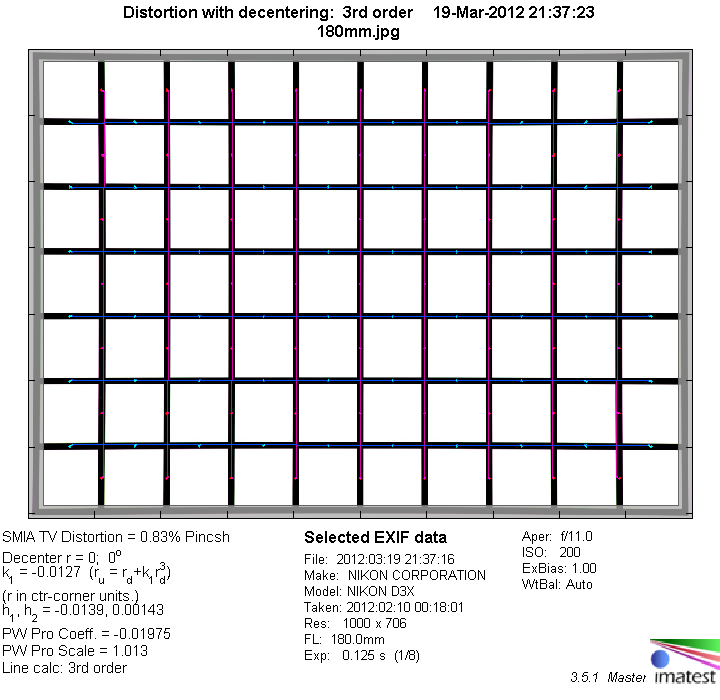|
Page 2 of 3

Distortion
The lens shows a small amount of pincushion distortion, that may be visible in subjects with straight lines towards the image borders, but should not be an issue with the majority of subjects one usually shoots with a fast prime lens (like portraiture).

The chart above has a real-world size of about 120x80cm.
Vignetting
Vignetting is well controlled for a f/2.8 FX lens. There is a moderate amount of light fall-off towards the corners wide open. Stopped down, vignetting is reduced to lower and for most subjects irrelevant levels.
We're performing our vignetting analysis based on
(uncorrected) JPEGs straight from the camera. The JPG engine of the Nikon D3x features a rather flat
gradation curve, thus has a moderate contrast characteristic, resulting in comparatively low vignetting figures - the
corresponding Canon figures are roughly 40% higher due to the more
aggressive default contrast setting.

MTF (resolution)
The lens shows excellent resolution in the image center wide open already and remains on this high level down to f/8. At f/11 (and beyond) diffraction takes its toll and significantly reduces resolution again.
The borders and corners follow one step behind with very good resolution across the tested aperture range, except for the extreme corners, that stay just a bit below this level wide open and at f/11.
Please note that the MTF results are not directly comparable across the different systems!
Below is a simplified summary of the formal findings. The chart shows line widths
per picture height (LW/PH) which can be taken as a measure for sharpness.
If you want to know more about the MTF50 figures you may check out the corresponding
Imatest Explanations

Chromatic Aberrations (CAs)
Chromatic aberrations (color shadows at harsh contrast transitions) are very low and well controlled wide open, but increase to slightly higher levels when stopping down. However, CAs can easily be corrected in software or by the camera itself (most modern Nikon DSLRs remove CAs themselves if you shoot JPGs).

Bokeh
One of the primary usage scenarios for a large aperture lens is to seperate the main subject from the background. In such an image the quality of the bokeh (out-of-focus blur) is of major significance.
The background blur shows some signs of nervousness in the transition zone from in-focus to out-of-focus, but apart from that is generally quite smooth.
Background highlights show only a very small amount of outlining and are actually well rendered. However, they are slightly cut off towards the image borders due to mechanical vignetting and start to lose their circular shape at apertures of f/5.6 and smaller. In addition, there's a visible amount of bokeh fringing (green outlines, see next section).

Bokeh Fringing
Bokeh fringing is a common issue with relatively fast glass. It's visible as halos of different colors in out-of-focus areas - magenta (red + blue) in front of the focus point
and green beyond.
Typical for most fast primes the AF-D 180 shows noticeable bokeh fringing at large aperture settings, which can of course be reduced by stopping down.
Flare/Glare
The lens does not really like backlight and visibly loses contrast across the whole image in these conditions. In addition to the glare, there are also traces of soft flare spots, but depending on the subject they may not be visible at all. IN the sample image below, you can see a green haze spot close to the lower border of the image.

|